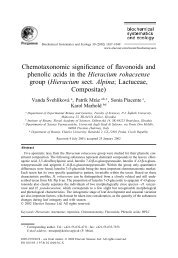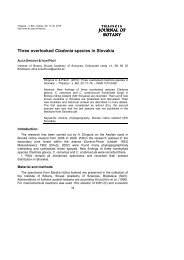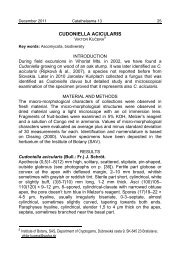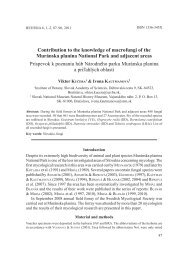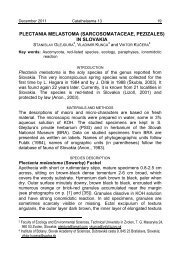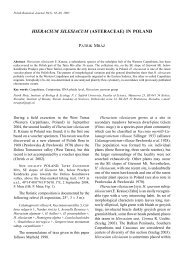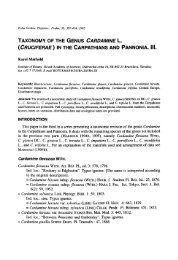Typification of the Linnaean names of the genus - institute of botany ...
Typification of the Linnaean names of the genus - institute of botany ...
Typification of the Linnaean names of the genus - institute of botany ...
You also want an ePaper? Increase the reach of your titles
YUMPU automatically turns print PDFs into web optimized ePapers that Google loves.
LINNAEAN NAMES OF THE GENUS CARDAMINE<br />
protologue, and by a description and reference to a locality: “Circa fontes &<br />
rivulorum margines montis Bargae in Hetruria [Tuscany] crebro nascitur”. In spite <strong>of</strong><br />
<strong>the</strong> poor quality <strong>of</strong> <strong>the</strong> illustration, <strong>the</strong> plant depicted <strong>the</strong>re undoubtedly belongs to<br />
C. asarifolia as used in <strong>the</strong> current literature (e.g. Jones, 1964a: 286; Jones & Akeroyd,<br />
1993: 348). Attempts to trace a specimen connected with this illustration in <strong>the</strong><br />
herbaria where Boccone’s specimens are deposited (BOLO, GE, IBF, LY, P, OXF,<br />
and in <strong>the</strong> Austrian National Library, Vienna - cf. Lanjouw & Stafleu, 1954: 80;<br />
Stafleu & Cowan, 1976: 243) were not successful.<br />
In Hermann’s Paradisus batavus (1698) <strong>the</strong> polynomial “NASTURTIUM montanum<br />
Assari folio” is cited with direct reference to Boccone (1674) and with<br />
reference to “Sisembro Alpino palustre di foglia rotonda” (as “Nasturtii Alpini<br />
palustris rotundifolii” in Hermann) <strong>of</strong> Zanoni in Istoria botanica (1675). The entry is<br />
completed by a short description and a very accurate illustration, cited by Linnaeus<br />
in <strong>the</strong> protologue, exhibiting all <strong>the</strong> characters diagnostic <strong>of</strong> this taxon. It is<br />
important to note that according to an early draft <strong>of</strong> part <strong>of</strong> <strong>the</strong> Paradisus batavus (MS<br />
Sherard no. 181/2, p. 129, see above), <strong>the</strong> whole entry for “Nasturtium montanum<br />
Assari folio” in Paradisus batavus was most probably written by William Sherard. Thus<br />
<strong>the</strong> undated specimen <strong>of</strong> C. asarifolia in Sherard’s herbarium (OXF, no. 3795) with<br />
Sherard’s reference to “Nasturtium montanum Asari folio Bocc. rar. pl. 5. Par. Bat.<br />
120 [sic!]” on <strong>the</strong> label might be conceptually linked to <strong>the</strong> entry in <strong>the</strong> Paradisus<br />
batavus. The specimen indeed perfectly agrees with <strong>the</strong> current concept <strong>of</strong> C.<br />
asarifolia.<br />
Ray in Historia plantarum (1686) referred to Zanoni’s detailed entry for his<br />
“Sisembro Alpino palustre di foglia rotonda” (as “Nasturtium Alpinum palustre<br />
rotundifolium” in Ray) (Zanoni, 1675) and Boccone’s entry for “Nasturtium<br />
montanum Asari folio” (Boccone, 1674).<br />
Morison in Plantarum historiae universalis oxoniensis (1680) introduced his own phrase<br />
name “Nasturtium Alpinum palustre rotundifolium radice serpente”, which slightly<br />
differs from Linnaeus’s citation in <strong>the</strong> protologue. The polynomial is accompanied<br />
by a detailed description, a reference to Zanoni’s aforementioned phrase name and<br />
by <strong>the</strong> location already mentioned in Zanoni’s work “Reperitur in loco aperto, ubi<br />
pascuntur pecora, in territorio Modenensi, prope fontem jugem aquae limpidae &<br />
frigidissimae, qui ab indigenis pastoribus Baccara appelatur”.<br />
The last cited polynomial in <strong>the</strong> protologue is that <strong>of</strong> Bauhin “Nasturtium alpinum<br />
bellidis folio majus” from Pinax (Bauhin, 1623) and Prodromus (Bauhin, 1620) with a<br />
question mark appended, since Linnaeus apparently had some doubts about this<br />
synonym. This is confirmed by <strong>the</strong> fact that in his own copy <strong>of</strong> Pinax (Bauhin, 1671),<br />
deposited in <strong>the</strong> Library <strong>of</strong> <strong>the</strong> Linnean Society, London, he deleted his original<br />
inscription “Cardam. asarifolia” near this polynomial and wrote instead <strong>the</strong> generic<br />
name “Arabis”. Bauhin in Pinax (1623: 105) referred directly to <strong>the</strong> entry in Prodromus<br />
(1620: 46), where he wrote a short description and cited <strong>the</strong> specimen collected by<br />
Burserus “Circa Fabarias Thermas [Pfäfers, E. Switzerland]”. The relevant<br />
specimen (or its duplicate) was originally in volume V <strong>of</strong> Burser’s herbarium (Hortus<br />
siccus), which was destroyed by fire in 1702. However, it belonged to Arabis soyeri<br />
Reuter & Huet (syn.: Arabis bellidifolia Jacq. non Crantz) (Juel, 1923: 48; 1936: 30).<br />
After considering all <strong>of</strong> <strong>the</strong> elements from <strong>the</strong> protologue, <strong>the</strong> illustration in<br />
Hermann’s Paradisus batavus is designated here as <strong>the</strong> lectotype <strong>of</strong> Cardamine asarifolia<br />
L.<br />
115



